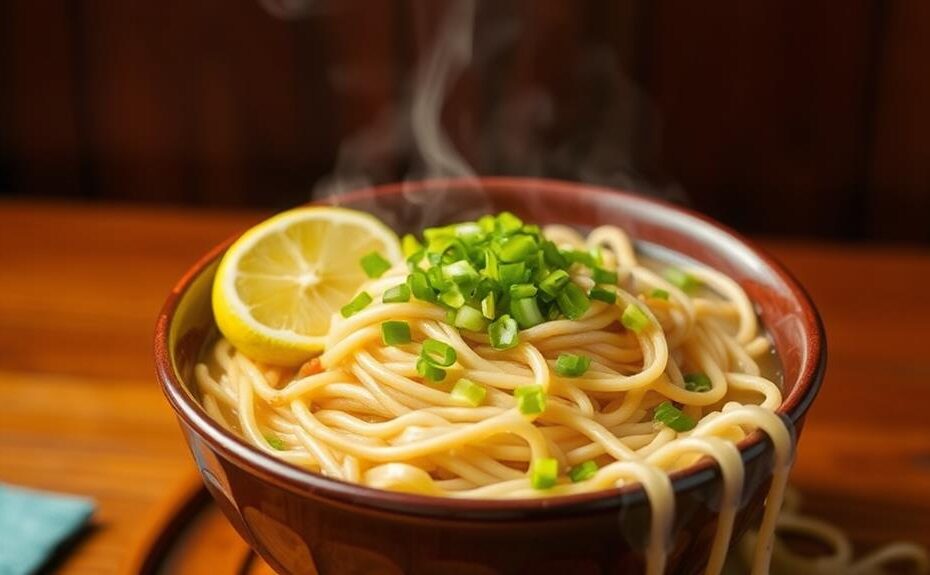Prep Ingredients Like a Pro
To create an unforgettable Pancit Lomi, start by preparing high-quality ingredients. Use thinly sliced pork belly, bone-in chicken pieces, and reconstituted dried mushrooms to ensure rich flavors and textures.
Cook Lomi Noodles to Perfection
Blanch lomi noodles for just 30 seconds to prevent overcooking. Then, add them to your flavorful broth towards the end of cooking to achieve the perfect texture.
Enhance Broth with Thickeners and Texture
Mix in a cornstarch slurry to thicken the broth and create a velvety consistency. Add beaten eggs to achieve a silky texture. These additions will elevate your Pancit Lomi to the next level.
Essential Ingredient Preparation
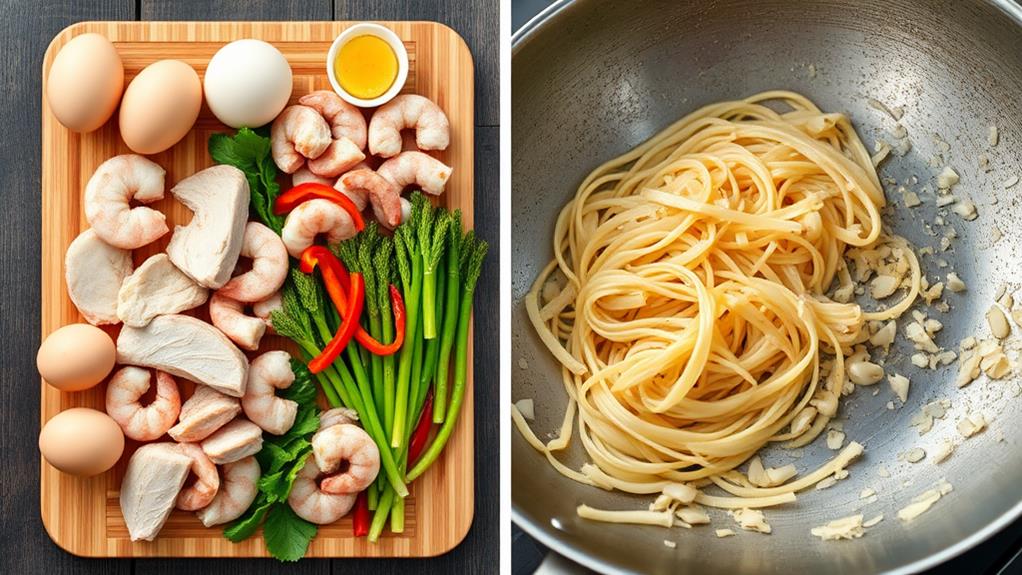
Proper ingredient preparation is crucial for a flavorful Pancit Lomi. To achieve this, slice the pork belly thinly for quick cooking and even flavor distribution. For chicken, use bone-in pieces to boil and reserve the rich, flavorful chicken broth, which serves as the base of the dish.
Cutting ingredients into smaller pieces enhances texture and taste. Cut fish balls and squid balls into smaller pieces and lightly brown them before adding them to the soup. This step adds texture and flavor to the dish.
Brief cooking prevents liver toughness. Cook liver briefly, whether it's chicken or pork, to ensure it remains tender and flavorful in the final dish.
Reconstituting dried mushrooms adds umami flavor. Soak dried mushrooms in water until softened, then slice them to incorporate into the soup. This step adds depth of flavor to the dish.
Cooking Lomi Noodles to Perfection
Achieving the Perfect Chewy Texture
To prevent lomi noodles from becoming mushy, blanch them in boiling water for 30 seconds, then rinse them under cold water and set aside. This step is crucial, as it helps maintain their texture.
Using fresh lomi noodles is essential, as they're thicker and provide the authentic texture that distinguishes Pancit Lomi from other noodle soups.
Incorporating Noodles into the Broth
When adding lomi noodles to the broth, add them towards the end of the cooking process. This ensures they absorb the flavors without overcooking.
To thicken the soup and enhance the noodles' flavor, create a cornstarch slurry by mixing cornstarch with water, and stir it into the broth gradually while simmering.
Adding Extra Flavor
For an extra layer of flavor, consider adding beaten eggs slowly while stirring the broth to create a silky texture that complements the lomi noodles.
Mastering the Savory Broth
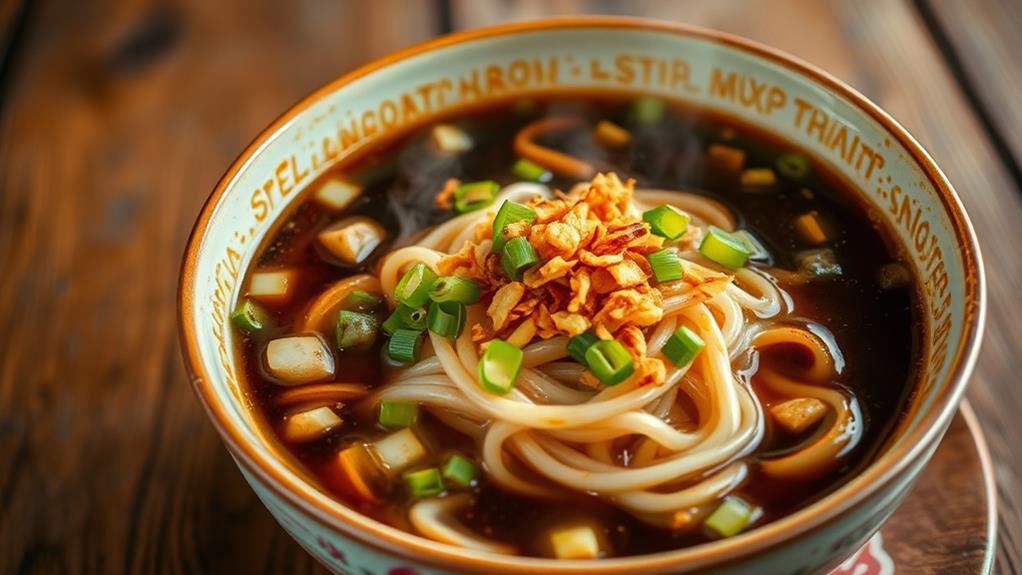
Mastering the Savory Broth
A rich and savory broth is essential for a great Pancit Lomi. To achieve this, follow these essential steps:
Simmer bones for depth: Combine pork and chicken bones and simmer for at least 1-2 hours to extract maximum flavor and depth. This extended simmering time allows for the release of collagen, which adds body and richness to the broth.
Add aromatics for complexity: Incorporate aromatics like garlic, onions, and ginger during the simmering process to enhance the overall taste of the broth. These aromatics add layers of flavor and aroma, making the broth more complex and engaging.
Balance flavors with umami: Use fish sauce and soy sauce to add umami flavor, adjusting the quantities based on personal preference and the saltiness of the other ingredients. These umami-rich ingredients deepen the flavor of the broth and create a savory taste experience.
To complete the broth, mix in a cornstarch slurry to thicken it, and finish it with a drizzle of beaten eggs to create a silky texture.
Expert Tips for Uniform Cooking
Uniform Sizes Matter
Cut all vegetables and meats into uniform sizes to ensure even cooking. This prevents some pieces from being overcooked while others remain undercooked, resulting in a dish with varied textures.
Preserve Noodle Texture
Blanch Lomi noodles for 30 seconds in boiling water before adding them to the soup. This maintains their chewy texture and prevents them from becoming mushy.
Enhance Flavor and Texture
When sautéing, start with garlic and onions in hot oil to enhance their flavor. This allows for a more uniform distribution of taste throughout the dish.
Choose Vegetables Wisely
Select vegetables with similar cooking times to ensure they all become tender at the same rate. This maintains the desired texture of the dish.
Thicken with Care
When thickening the broth with cornstarch slurry, stir regularly to avoid lumps and promote an even consistency in the soup.
Customizing With Toppings and Variations
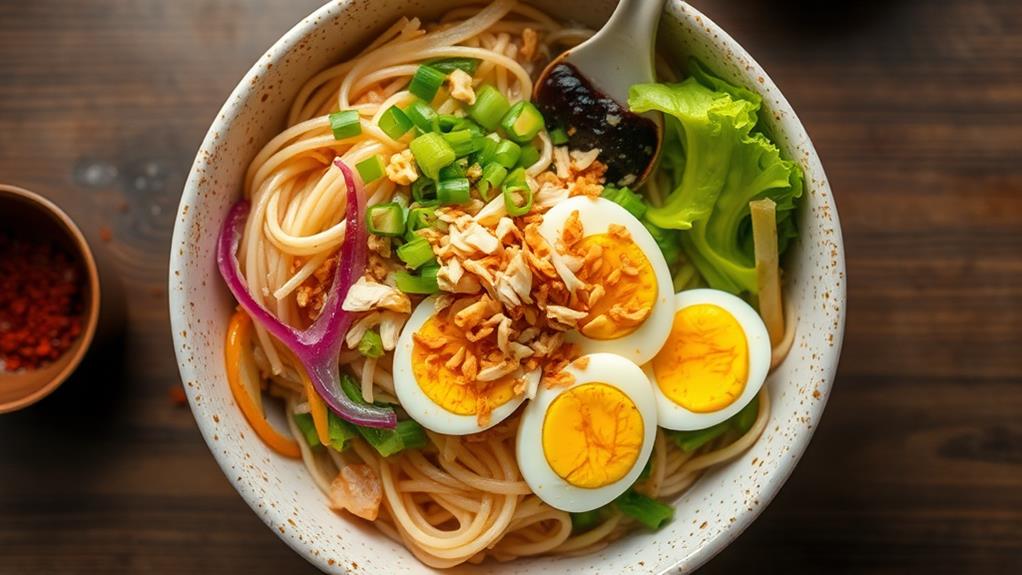
Customizing Pancit Lomi with Toppings and Variations
Incorporating various toppings and variations can elevate Pancit Lomi to a new level of flavor and excitement.
Customization Options
Protein-Rich Variation: Adding hard-boiled eggs and crispy lechon kawali increases the protein content and texture of the dish.
This combination of soft noodles, crunchy pork, and creamy eggs provides a unique experience.
Seafood-Inspired Twist: Introducing shrimp or squid balls gives Pancit Lomi a seafood spin, changing the flavor profile and providing a satisfying bite.
Veggie-Focused Option: Incorporating seasonal vegetables like bell peppers or bok choy adds color, nutrition, and freshness to the dish.
Adjusting the spice level with chili flakes or fresh chili peppers is also possible.
Cooking in Batches for Ease
Streamline Your Cooking with Batch Cooking
Batch cooking is an efficient method that ensures a stress-free cooking experience when making Pancit Lomi.
It prevents overcrowding in the pan and achieves even cooking, resulting in consistently cooked ingredients.
Benefits of Cooking in Batches
Even Cooking: Batch cooking prevents uneven heat distribution, ensuring that all ingredients are cooked to perfection.
Prevents Overcrowding: Cooking in batches prevents noodles from breaking and retains their chewy texture.
Achieves Nice Sear: It allows for a nice sear on meat and vegetables, enhancing their flavor and texture.
Efficient Cooking: Batch cooking enables quick addition of prepared ingredients, making the cooking process faster.
Warm Finished Ingredients: It keeps cooked ingredients warm until they're ready to be combined, ensuring a hot and fresh dish.
To cook in batches effectively, prepare all ingredients ahead of time to avoid delays.
After cooking each batch, keep the finished ingredients warm in a low-heat oven or covered on the stovetop until all components are ready to combine.
Preserving Noodle Texture and Presentation
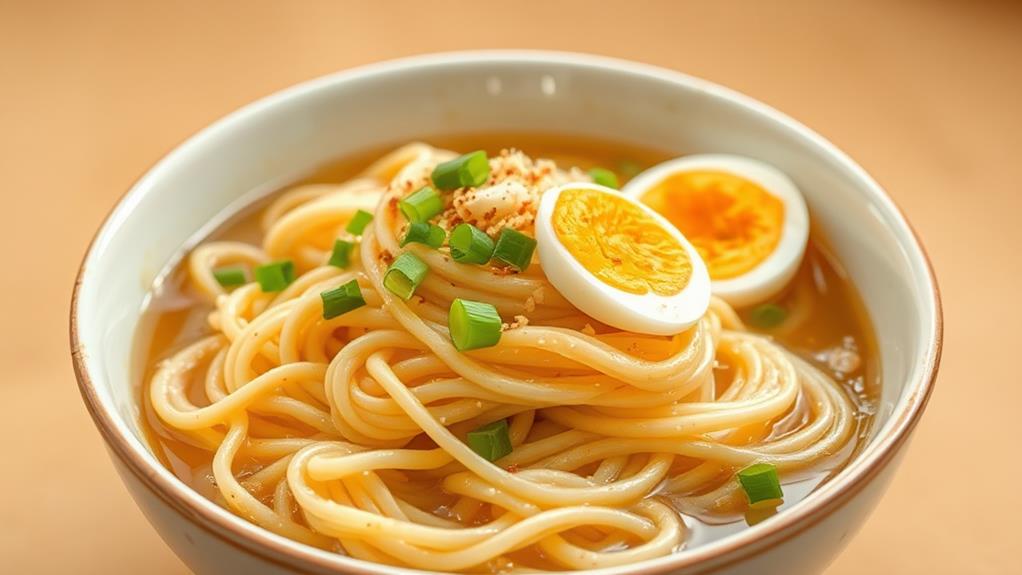
Preserving Noodle Texture and Presentation in Pancit Lomi
Pancit Lomi's noodle texture and presentation can deteriorate rapidly after cooking. To maintain the dish's signature chewy noodles and vibrant presentation, follow these expert tips:
Tip 1: Blanch and Chill Noodles
Blanch lomi noodles in boiling water for 30 seconds, then rinse them in cold water and set them aside. This step prevents the noodles from becoming mushy.
Tip 2: Thicken Broth Gradually
Use a cornstarch slurry to thicken the broth, stirring continuously to avoid lumps and ensure a smooth texture. This prevents the broth from becoming too thick or lumpy.
Tip 3: Add Eggs and Vegetables with Care
When adding beaten eggs to the soup, do so slowly while stirring to create ribbons of egg rather than clumps.
Additionally, cut vegetables into uniform sizes to ensure even cooking and a visually appealing bowl.
Common Cooking Mistakes to Avoid
Common Mistakes to Avoid in Pancit Lomi
Mistake 1: Overcooking the Liver
Cooking the liver until it's just lightly browned at the edges ensures optimal tenderness. Overcooking can lead to a tough and chewy texture.
Mistake 2: Overcooking the Lomi Noodles
Blanching lomi noodles for only 30 seconds prevents a mushy texture. Gentle cooking is essential to maintain the noodles' authentic chewy texture.
Mistake 3: Lumpy Broth
When thickening the broth with cornstarch, stir the slurry continuously to prevent lumps and achieve a smooth consistency.
Mistake 4: Using Low-Quality Noodles
Using fresh, high-quality lomi noodles is essential to achieve the authentic chewy texture that defines this dish.
Mistake 5: Neglecting Seasoning Adjustment
Tasting and adjusting the seasoning during the cooking process ensures a balanced flavor profile that enhances the overall dish.
Don't skip this crucial step to avoid a dish that's too salty or bland.
Storage and Reheating Techniques
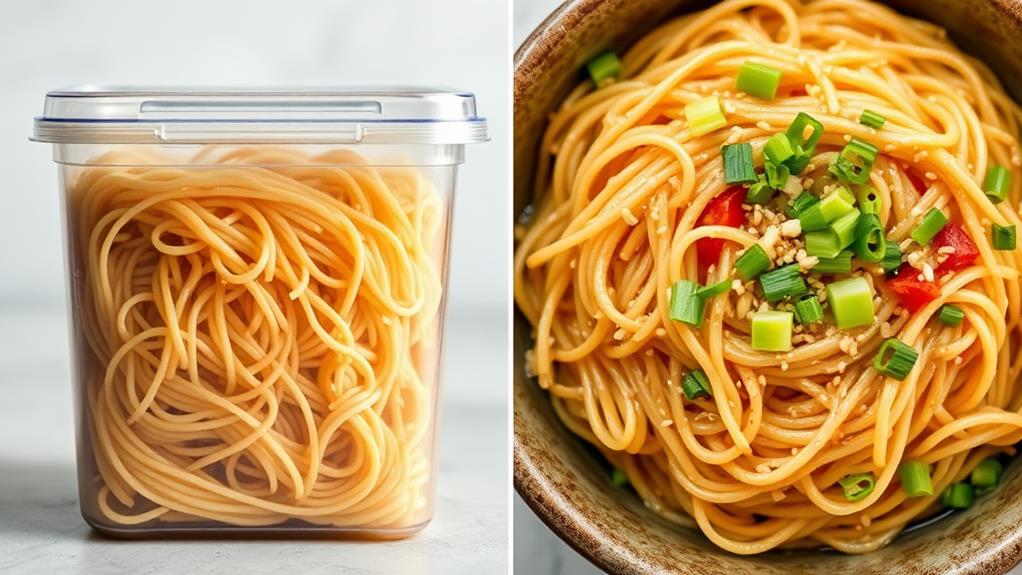
Proper Storage and Reheating Techniques for Pancit Lomi
To keep your leftover Pancit Lomi fresh, store it in a tightly sealed container in the refrigerator for up to 3 days.
When reheating, follow these tips:
Reheat in Intervals: Reheat in 2-3 minute intervals, stirring occasionally, to ensure even heating throughout.
Adjust Consistency as Needed: If the soup thickens too much during storage, add a splash of water or broth to restore the desired consistency.
Reheat Only What You Need: Reheat only the portion you plan to consume at one time to prevent the entire batch from losing its quality.
Can I Use These Cooking Tips for Pancit Lomi to Make Authentic Pancit Food?
Looking for an authentic pancit food recipe? These cooking tips for Pancit Lomi will help you create a truly delicious and traditional dish. From choosing the right noodles to incorporating the perfect blend of flavors, you can use these tips to make an authentic pancit that will impress your guests.
Serving Suggestions and Pairings
Serving Suggestions
Presenting Pancit Lomi: To showcase the comforting, savory flavors and hearty texture of Pancit Lomi, garnish it with green onions, fried garlic bits, and slices of hard-boiled eggs.
Serve with calamansi or lemon wedges on the side to enhance the flavors and provide a zesty contrast to the rich, flavorful broth.
Pairing with Traditional Filipino Sides: Pair Pancit Lomi with traditional Filipino sides like puto (steamed rice cakes) or pandesal (soft bread rolls) for a more filling meal.
Adding Crispy Toppings: Consider presenting Lomi with crispy toppings such as chicharon (crispy pork skin) or lechon kawali (crispy fried pork belly) to elevate the dish's flavor profile and add a delightful crunch.
Frequently Asked Questions
What to Pair With Lomi?
Balancing Flavors with Lomi
When pairing with lomi, it's essential to balance out its rich flavors with bright, tangy notes.
Serve lomi with a side of puto or pandesal to create a sweet and savory contrast.
Adding crispy toppings like chicharon provides a delightful crunch.
Offer dipping sauces like spicy vinegar or chili sauce to let diners customize the heat level to their preference.
For a more elaborate dish, garnish with calamansi slices or add protein like cooked pork or chicken.
Why Is Lomi Delicious?
Lomi's flavor profile is the key to its deliciousness. This profile combines rich broth, savory proteins, and fresh veggies, creating a harmonious balance of flavors. For instance, the rich broth is typically made with pork or chicken stock, while the savory proteins can include braised pork belly or boiled chicken. Fresh veggies like baby bok choy and scallions add a pop of color and texture.
The texture contrast in lomi is a major contributor to its appeal. The chewy noodles, typically made from egg noodles or thick rice noodles, provide a satisfying bite. In contrast, the tender meats, such as braised pork belly or boiled chicken, melt in your mouth. This contrast creates a delightful eating experience.
Using fresh ingredients and exploring regional variations can elevate lomi to the next level. Fresh ingredients like baby bok choy and scallions ensure a bright, fresh flavor. Regional variations, such as adding dried shrimp or using different types of noodles, can introduce new flavors and textures.
Mastering cooking techniques is crucial to making exceptional lomi. Thickening the broth with cornstarch or flour creates a rich, velvety texture. Garnishing with crispy pork belly adds a satisfying crunch.
What Is a Substitute for Lomi Noodles?
Fresh egg noodles or udon noodles are suitable substitutes for lomi noodles, offering a similar chewy texture. These noodles can be used interchangeably in most recipes.
If fresh noodles aren't available, dried egg noodles can be used as a substitute. However, they need to be cooked according to the package instructions.
For those who require a gluten-free option, rice noodles can be used, but they'll alter the flavor and texture of the dish.
For a low-carb alternative, zucchini noodles or shirataki noodles can be used, but they'll change the taste and consistency of the dish.
Cassava noodles mimic the thickness of lomi noodles, but their cooking methods may vary.
What Is the Difference Between Lomi and Mami Noodles?
Lomi noodles have a chewy, thick texture, making them perfect for hearty soups.
They're able to hold up to thickened soups because of their texture.
On the other hand, Mami noodles are soft and delicate, ideal for lighter broths.
Their softness allows them to excel in clear broths.
The difference in texture is due to the ingredients used in each type of noodle.
This difference impacts the serving styles of the noodles.
Lomi noodles are suitable for thickened soups, while Mami noodles are better suited for clear broths.
Understanding these differences allows for a greater range of flavors and textures in dishes.
